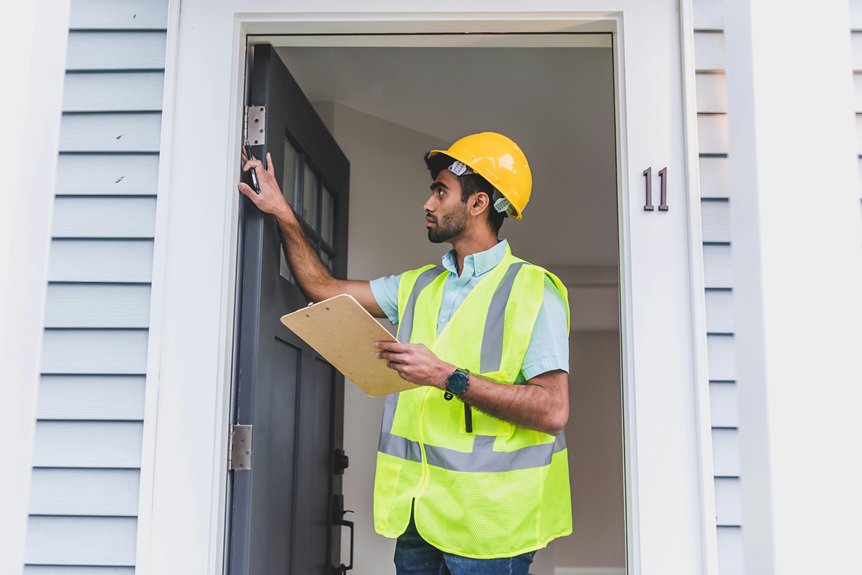When you schedule a home maintenance inspection, you can expect a thorough assessment of your property’s essential systems. Inspectors will focus on plumbing, electrical systems, and HVAC, along with the condition of your roof and appliances. They’ll identify safety compliance issues and potential repairs that could save you money in the long run. Understanding what to prepare for can help you make the most of this crucial evaluation. But what specific areas should you pay attention to beforehand?
Key Takeaways
- Expect a thorough assessment of key areas like the roof, plumbing, electrical systems, and heating/cooling units for potential issues.
- The inspector will check for compliance with safety regulations and energy efficiency standards throughout your home.
- Be prepared for evaluations of interior spaces, ensuring adequate lighting, ventilation, and unobstructed pathways for safety.
- Post-inspection, you’ll receive a detailed report highlighting findings and recommendations for necessary repairs and maintenance tasks.
- Routine inspections can help prevent costly repairs and enhance the overall safety and comfort of your home.
Understanding the Purpose of a Home Maintenance Inspection

When you think about maintaining your home, it’s easy to overlook the importance of a thorough inspection. Understanding the purpose of a home maintenance inspection is vital for preserving your property’s value and safety.
Key importance factors include identifying potential issues before they escalate, ensuring compliance with safety regulations, and enhancing energy efficiency. Regular inspections can help you stay ahead of costly repairs, giving you peace of mind.
Ideally, you should schedule these assessments annually or biannually, depending on your home’s age and condition. By staying proactive, you can protect your investment and create a safe living environment for your family.
Key Areas Typically Assessed
A thorough home maintenance inspection covers several key areas that are essential for guaranteeing the overall safety and functionality of your property.
Your home inspector will typically assess the roof, plumbing, electrical systems, heating and cooling units, and the foundation. They’ll check for signs of wear, water damage, and pest infestations.
Additionally, the exterior and interior conditions, including windows, doors, and insulation, will be evaluated.
Having a detailed maintenance checklist helps you identify potential issues before they escalate.
Preparing Your Home for the Inspection
How can you guarantee your home is ready for inspection? Start by creating a thorough cleaning checklist. Focus on tidying up each room, decluttering surfaces, and making sure all areas are accessible.
Next, address any necessary repair preparations; fix leaky faucets, replace burnt-out light bulbs, and patch any wall holes. Make certain all appliances are functional and clean.
Address necessary repairs by fixing leaks, replacing bulbs, and ensuring appliances are clean and functional for a smooth inspection.
Don’t forget the exterior; mow the lawn and clear debris from walkways.
Finally, gather any relevant documents, such as warranties and maintenance records, to provide to the inspector. A well-prepared home reflects your attention to detail and might ease the inspection process.
What Inspectors Look for in the Exterior
Inspectors closely examine the exterior of your home to identify potential issues that could affect its value and safety.
They assess the condition of exterior materials, looking for signs of wear, damage, or decay. Cracks in siding, peeling paint, or rotting wood can indicate larger problems.
Additionally, inspectors evaluate landscaping concerns, such as overgrown vegetation that may impact your foundation or drainage systems.
They’ll check for proper grading to guarantee water drains away from your home, preventing moisture issues.
Evaluating the Roof and Gutters
When evaluating your roof and gutters, start by inspecting the condition of the shingles and flashing for any signs of wear or damage.
Next, assess the functionality of your gutters to guarantee they effectively channel water away from your home.
Finally, look for any structural damage that could compromise the integrity of your roofing system.
Inspecting Shingles and Flashing
Regularly inspecting shingles and flashing is essential for maintaining the integrity of your roof and gutters.
Look for signs of shingle deterioration, such as curling, cracks, or missing pieces, as these can lead to leaks and further damage.
Check the flashing around chimneys, vents, and valleys for any gaps or rust, which can compromise their integrity.
Make certain that the flashing is securely attached and properly angled to direct water away from vulnerable areas.
Assessing Gutter Functionality
How well are your gutters functioning? Proper gutter maintenance is essential to prevent water damage.
Start by inspecting for clogs; leaves and debris can block the flow, leading to overflow. One of the best gutter maintenance tips is to clean them at least twice a year.
If you notice standing water or sagging sections, it’s time for clogged gutters solutions, like using a plumber’s snake or a pressure washer.
Make sure downspouts direct water away from your foundation to avoid structural issues.
Identifying Structural Damage
Structural integrity is vital for the safety and longevity of your home, so evaluating the roof and gutters for damage is indispensable.
Start by inspecting the roof for missing shingles, sagging areas, or leaks, as these can lead to issues with load bearing walls.
Next, examine the gutters for blockages and make certain they direct water away from your home’s foundation.
Look for foundation cracks, which may indicate water pooling around the base.
Addressing any signs of structural damage promptly can prevent costly repairs and guarantee your home remains safe and sound for years to come.
Inspecting Plumbing and Water Systems

While you mightn’t think about it often, inspecting your plumbing and water systems is essential for maintaining a safe and efficient home.
Start by checking for any pipe leaks, as even small drips can lead to significant water damage over time.
Examine the water pressure in your faucets and showerheads; low pressure can indicate clogs or issues within your plumbing.
Don’t forget to inspect your water heater for rust or leaks, and verify that all shut-off valves function properly.
Regular inspections can prevent costly repairs and keep your water systems running smoothly, providing peace of mind for you and your family.
Assessing Electrical Systems
When evaluating your electrical systems, you’ll want to start by examining the wiring and connections throughout your home.
Next, check the circuit breaker panel for any signs of wear or malfunction, ensuring it’s functioning properly.
Finally, confirm that grounding and bonding are correctly implemented to protect your home from electrical hazards.
Wiring and Connections
Evaluating your home’s wiring and connections is essential for guaranteeing safety and functionality in your electrical system.
During an inspection, focus on wiring safety by checking for frayed or damaged wires, which can pose serious hazards. Look for signs of overheating, such as discoloration or a burnt smell.
Assess connection integrity by confirming all junctions and plugs are secure and free from corrosion. Loose connections can lead to arcing, increasing fire risks.
Additionally, verify that your wiring meets current codes. A thorough evaluation can help prevent electrical failures and guarantee your home remains safe and efficient.
Circuit Breaker Panel
The circuit breaker panel serves as the heart of your home’s electrical system, safeguarding against overloads and short circuits.
During your inspection, assess the circuit breaker functionality by checking for any tripped breakers or signs of wear. Make sure that the panel is clean and free from moisture, which can compromise its performance.
Regular circuit breaker maintenance is essential; tighten any loose connections and replace outdated breakers as needed. If you notice any burning smells or unusual noises, address these issues immediately to prevent hazards.
Keeping your circuit breaker panel in peak condition guarantees safety and efficiency in your home’s electrical system.
Grounding and Bonding
Grounding and bonding play an essential role in guaranteeing your home’s electrical safety, as they help mitigate the risk of electrical shock and fire hazards.
During the inspection, you’ll want to check your grounding systems, which connect electrical installations to the ground, providing a safe path for excess electricity.
Inspectors will also evaluate bonding techniques, which link various metal components to guarantee they share the same electrical potential, preventing shock risks.
Look for signs of corrosion or loose connections, as these can compromise the effectiveness of your grounding and bonding, leading to dangerous situations.
Confirming these systems are intact is crucial for safety.
Checking Heating and Cooling Systems
Guaranteeing your heating and cooling systems are in ideal condition is essential for maintaining a comfortable home environment. During your inspection, check your furnace efficiency and verify your air conditioning unit is functioning properly. Regular maintenance can prevent costly repairs and improve energy efficiency.
| System Type | Key Maintenance Tasks | Frequency |
|---|---|---|
| Furnace | Change filters, clean ducts | Every 3 months |
| Air Conditioning | Check refrigerant levels | Annually |
| Thermostat | Calibrate settings | Once a year |
| Vents | Clear blockages | Every 6 months |
A well-maintained system guarantees your home stays comfortable year-round.
Reviewing Interior Spaces and Safety Features
While you might focus on the exterior of your home, reviewing interior spaces and safety features is equally essential for maintaining a safe and comfortable living environment.
Assess the functionality of each space, ensuring it meets your needs and promotes efficient use. Check for adequate lighting, proper ventilation, and unobstructed pathways.
Inspect smoke detectors, carbon monoxide alarms, and fire extinguishers to guarantee interior safety. Look for signs of mold or moisture, which can affect both health and space functionality.
Post-Inspection: Next Steps and Recommendations

After completing your home maintenance inspection, it’s crucial to prioritize the findings and create a plan for addressing any identified issues.
Review your post-inspection report carefully and consider these follow-up actions:
- Address Critical Repairs: Tackle any urgent issues that could compromise safety or lead to further damage.
- Schedule Routine Maintenance: Set up a timeline for regular upkeep based on the inspector’s recommendations.
- Budget for Future Projects: Allocate funds for any significant repairs or improvements highlighted in the report.
Conclusion
To summarize, a home maintenance inspection is essential for ensuring your property remains safe and functional. By understanding what to expect and preparing accordingly, you can facilitate a smoother evaluation process. The inspector’s thorough assessment of key areas—from the roof to the electrical systems—provides invaluable insights into your home’s condition. After the inspection, review the detailed report carefully to address any necessary repairs and prioritize ongoing maintenance, ultimately protecting your investment and enhancing your living environment.

